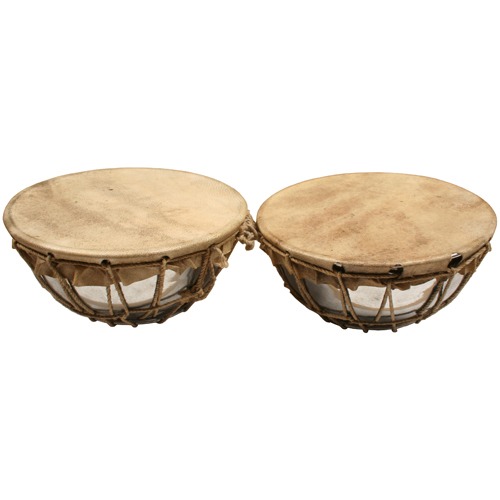Naqareh, also known as Naqqara and Nagada, is a pair of Middle Eastern percussion instrument that has a rounded back and a head made out of a hide. The rounded section of this instrument is made out of baked clay. Meanwhile, its flat side is an animal skin fastened around using a string that is tightened over the back of the instrument. Its name, naqareh or nagara, literally means “beat” or ‘strike’ in Arabic. When this instrument was adopted in Europe, it becomes notably known as ‘naccaire’ or ‘naker.’ Since this instrument is a type of drum, it is typically struck using a short wooden stick that is bent outward at its upper end called damka. Additionally, the naqareh produces a low pitch beat called ‘nar.’ Aside from that, it can also be played in a high-pitch register. There are several types of naqareh that are existing in several parts of the world like in Iran, India, Azerbaijan, Turkey, Uzbekistan, Europe, and Georgia.
In some regions of Iran, several sizes of naqareh were presented. Some of these were the Naqare-ye Shomal, Desarkutan, Fars Naqqare, Sanandaji, and Naqqarekhan.
Naqare-ye Shomal: The Naqare-ye Shomal, also known as the northern naqqare, is usually played in the northern part of Iran. This type of naqareh was also called ‘desakurtan’ in the province of Mazandaran. The desarkutan is a pair of small drums which is made out of clay. Its structure is similar to a bowl. Although this type is played in pairs, one drum is larger than the other. The larger drum is called bam (bass), while the smaller one is called zil (treble). The larger drum measures about twenty-two centimeters, while the smaller one is about sixteen centimeters. Their sizes may be different from each other but these two are both covered with a cowhide or boarhide.
In playing this instrument, the desarkutan is struck using a stick that is 25-27 centimeters long, while its diameter is about 1 to 1.5 centimeter. Additionally, a thicker drumstick is used in playing the larger drum or the ‘bam.’ Most commonly, this naqareh is played during festive ceremonies like sports, wedding ceremonies, and others. However, it is important to note that the desarkutan is not used as a solo instrument.
Fars Naqqare: The Fars Naqqare is a type of naqareh played in the Fars province of Iran. This type of naqare is a little larger than a regular naqareh.
Sanandaji naqqare: It is a type of naraqeh that is usually played in the Sanandaj City, Iran.
Naqqarekhan: In Iran, the word ‘khane; literally means ‘home’ or ‘house.’ This type of naqareh is used for announcing important news through playing a kettle drum during a victory, the rising of the sun, mourning, or even during the birth of a male baby.
Furthermore, the naqareh can also be found in India, where it was pronounced as ‘nagara’ or ‘nagada.’ Like the Iranian naqareh, the Indian’s nagara were also a pair of kettledrums. In India, this pair of drums were used in the ‘naubat’ or ‘nine things,’ a traditional ensemble of nine instruments. As well as that, the nagara is also played using sticks. Nowadays, this instrument is commonly played alongside the shehnai or the Indian oboe, a necessary instrument in every Indian wedding. Meanwhile, in Azerbaijan and Turkey, the naqareh is also referred to as naqara or nakkare, which means a small kettledrum struck using the hands or a pair of sticks.
The popularity of the naqareh had also reached the Uzbekistan. In there, it is called nagora or naqara. Some variations were named ‘dulnaqara,’ a large kettledrum that produces a loud yet low sound. Another one is called ‘koshnaqara,’ a small pair of kettledrums made out of clay pots and goatskin tops. From the middle east, the naqareh had made its way to Europe during the 13th century Crusades. It was after the contact with the Arab musicians called the Saracens who played the said instrument. At that time, it had also spread out in France, Italy, and some other parts of England. Variations of the name had emerged because of this and the instrument was then known or called nacaires, naccheroni, and nakers.

